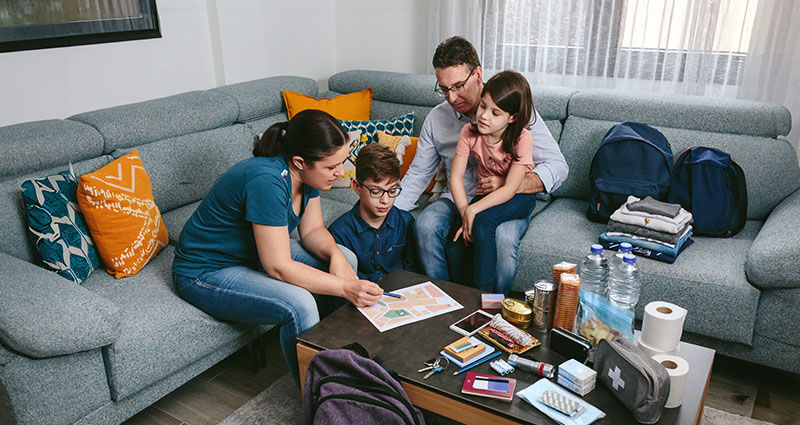When moving with kids, don’t forget to take care of yourself
Don’t underestimate the emotional, physical and mental requirements of a move for you and your family. Take time for yourself throughout planning, packing and physically moving. This includes taking a break every few hours to sit down with a glass of lemonade or hot tea or reading a few pages out of your current novel.
Schedule a date with your partner that gives you both time away from the house and a break from the kids.
Try to go to bed early and know that staying up late to do little jobs that could be done in the morning will only leave you stretched thinner.
Put yourself first, as hard as that may be, and you’ll see that everything else will flow with ease.
This also means taking care of the kids in a way that doesn’t stress you and your partner out. Get them out of the house and take them to the park to help get their energy out, go to the movies, or have a fun pizza night in a blanket fort with the boxes to help get them excited for the move as well.
How to announce the move to your kids
You know where you’re going, where you’ll be living and what your time frame is. So, how and when do you tell the kids about moving?
You know your child best. Some of them will react better if they’re told before the move is finalized, and some will prefer to know after you’ve chosen a new home. Start the process by sitting down and talking with your kids to allow them time to cope with the anxiety of moving. Even young children need to hear what the future looks like.
Allow space and time for them to ask questions. Why are we moving? Where are we moving to? What does it look like? Will they have their own room or a backyard?
You could help them visualize the move by pulling up a map online (or from an atlas) to show them the passage of travel you will take to get there, whether by plane or car.
Perhaps as you venture along the highways -- or even the streets if you’re moving within your current town -- you can show them how they'll now travel past the pond to get to school, or if moving to a new part of the country, how you now travel over a mountain range to get home or which rivers they'll live near.
Expect some emotions from children of all ages when it comes to moving. Even if you’re remaining in town, it can be difficult for kids to leave their current home.
Long-distance moves
If you are moving long-distance, your kids will be upset to lose the ability to see their friends. Reassure them that in today’s technical world, staying in touch is only a click away. They can connect once a week on Zoom, write old-fashioned pen pal letters or plan a visit next summer to spend a week together to maintain those friendships.
You can help manage the stress by reminding them about all the good that will come with the move, too. Maybe they’re getting more space to play or closer to family – whatever it is, reminding your kids that it’s not all bad may help them with the transition as well.
Be compassionate and sensitive when it comes to talking about moving. It can be very disruptive in the rhythm of life for children to relocate. By being open about it, you’ll save stress when the time comes to move.
How to pack when you’re moving with kids
Start now so you can relax and cuddle your kids later!
Packing is likely the biggest cause of stress for most parents, and the biggest time constraint. Get a head start. It’s the one part of moving that can ease the stress later down the line.
Your kids don’t care about how the kitchen, living room and bathroom items are packed. It’s their toys and trinkets that are their biggest concern.
Begin the process by explaining to very young children that their toys will be put into a safe place during the transition. You could even get creative and say it’s going into a treasure chest and or a magical box for just a short while. This way, they don’t have any anxiety about where their beloved items may be held for some time.
You can also include them in the process. Show your kids how to pack their toys and clothes into boxes and let them help you pack.
How about paring down and donating those toys that are no longer wanted to children who have much less? This can be a way of not only moving less stuff but also engaging your child in an act of generosity and philanthropy.
Once everything is bagged up for donation, allow them to ride with you to the drop-off. This could plant a seed for much more giving on their behalf down the line.
Moving day
If moving within the neighborhood, consider finding a neighbor, grandparent or friend to watch your children for the duration of the move. This way they are out from under your feet and distracted with their own playtime.
You could also consider having their friends over for one last sleepover with sleeping bags, especially when the house is empty. Make it an exciting night with a game of flashlight hide and seek and order pizza to keep the kitchen spotless.
The parents of those children could then do an exchange and have your children spend the night during the actual move. This would allow you a little more time to perhaps unpack a box or two and begin to make the new space feel like home.
If you’re moving to a new town or driving across the country with a toddler or child to a new state, then ask a grandparent, relative, or close friend if they are willing to come along with you. Perhaps they could fly back home once everyone is settled.
A grandparent can provide warmth and stability during a tumultuous time. They can be that soft place to land during a difficult transition for the whole family.
Driving to your new home
If your child is unfamiliar with long car trips and your move is taking you far away, prepare beforehand for the trip itself. Especially if you’re driving cross country with your toddler, you’ll want to have lots of tricks up your sleeves for an easy drive.
Tips for younger kids
Keep snacks in the car and always have some bottled water on hand. Keep a package of wipes handy for messes and easy clean-up.
During their waking hours, schedule a stop every two hours. Plan to make your way slowly to your new home, and factor in those little breaks.
Pick up some fun sticker books for them to work with and keep a stash of their favorite books in the backseat of the car. You might also play their favorite music to pass the time. This will keep the trip fun and lively.
Tips for older kids
For older children, bring along blank paper and colored pencils, perhaps an old digital camera they can now have to document their journey to a new home, or maybe a new comic book to pass the time. Think about buying them a blank journal for them to document the places they see along the way and write down their feelings about moving to a new home. An audiobook is also a great way to pass the time and forget about the miles.
No matter their age, don’t forget to keep the pillows in the car!
Preparing for a new school
If your child will be attending a new school, ease their anxiety with this process and give them all the tools possible to make an easy new start.
Look to see if there are parenting groups in the area and sign up to join them. Try to attend their first few meetings and introduce yourself as a family new to the area.
If the school has a parent community group, then join as soon as you’re able and sign up for a volunteer position when you’re settled. Look for some organizations your child can join before they start at the new school. Perhaps the presidents of the groups could give you names of families to connect with and children to arrange playdates with. This way, your child won’t go to school without knowing a single person. Even just one familiar face can warm the chill one feels from walking into new territory.
If there are any special events at school, be sure to attend them as well. This is a great way for parents and kids to meet one another without the peer pressure of a classroom.
We wish you and your family the best of luck as you transition into your new home.



































